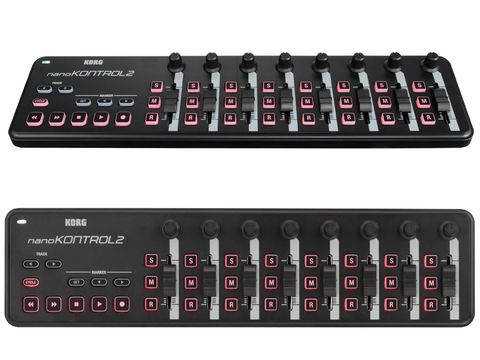Korg's original nanoSeries kickstarted the super-compact MIDI controller concept in late 2008, and competitor Akai responded with their slimline LPD8 and LPK25 units.
Korg now returns fire with the nanoSeries 2, which comprises three units. All are USB-powered class-compliant MIDI devices, meaning that you just plug them in and off you go - no need for drivers or external power supplies.
"The nanoKontrol2 seems more geared towards mixer control."
A sleeker and more rounded-out design makes the devices easier on the eye and in-keeping with the current trend for softer aesthetics.
Kontrol freak
Almost every single control on the new nanoKontrol is configurable via the Korg Editor software, making it a flexible general-purpose knobs, faders 'n' buttons MIDI controller.
Like the other devices, it's lightweight but still feels solid for what it is. Unlike the others devices, however, the nanoKontrol can now be used as a Mackie Control device. This gives you direct control of your DAW's transport and mixer channels, with minimal setup required.
Here, you get eight channels' worth of level, pan and solo/mute/record switching. The dedicated record buttons are new for series 2, although eagle-eyed nanolovers will have spotted that this new version has eight channels instead of the previous nine (which worked nicely as an 'eight plus master' configuration).
The new marker buttons let you set markers in your arrangement and jump back and forth between them, which is a great workflow-smoother. The new track select buttons let you page through the channels in banks of eight when in Mackie Control mode.
This effectively replaces the original's Scenes function, the advantage being that you can access more than four banks, while the drawback is that there's no LED indicator to tell you which bank you're currently in.
You also lose the option of having four separate scenes in MIDI mode (ie, four switchable configurations), while MMC (ie, MIDIbased transport control) has also disappeared. This means that you can't have a setup that easily combines DAW transport operation with MIDI control of synths, etc.
The new version seems more geared towards mixer control, then, but with such short faders and basic functionality, the value of this is questionable. Some users may therefore prefer the old nanoKontrol.
Editor's choice
The full feature-set of the original nanoSeries could only be accessed via the Kontrol Editor software, and this is still the case. There are a few changes for the new devices, though.
The previous nanoKontrol had attack and release options for its buttons, which faded CC changes in/out; these are now absent. Your custom configurations can be stored in the device itself, so no matter what you plug into - iPad included - your mappings will be ready to rock.
Note that you can download the Kontrol Editor before buying a nanoDevice to get a feel for its mapping possibilities.
The original nanoSeries turned out to be nifty companions for Apple's iPad, and this holds true. Apps that support Core MIDI (eg, GarageBand and Akai SynthStation) should work just fine.
Korg's own iElectribe and iMS20 apps sport a 'nano 2 native' mode, which will assign the controls appropriately when you plug in a nanoKontrol. Just be sure to disable this if you want your custom mapping to remain!
Some decent new functionality and a gentle makeover sees the nanoSeries heading in the right direction. However, fans of the first nanoSeries might be annoyed that certain features have been ditched to make way for new ones, rather than the existing feature-set being expanded.


